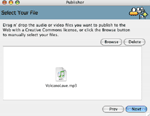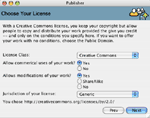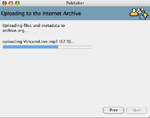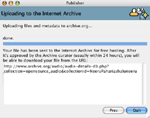[This email is part of a weekly series written by Lawrence Lessig and others about the history and future of Creative Commons. If you would like to be removed from this list, please click here:
https://creativecommons.org/about/lessigletter#unsubscribe
Alternatively, if you know others who might find these interesting, please recommend they sign up at
https://creativecommons.org/about/lessigletter ]
From last week’s email
And stay tuned next week when I’ll turn to some of the particular projects we’re working on right now — as well as ask again for your support.
The story continued
Creative Commons gives away code to offer creators a simple ability – to mark their creative work with the freedoms they want that work to carry. Code – both legal code (licenses) and technical code (software). I’ve spent a long time in these emails talking about the legal code. But most don’t know much about the technical code that we’ve created, even though, imho, it is some of the best stuff we’ve done.
But first, let’s be clear about our objectives here. We’re a small nonprofit. We can’t afford to be in the business of building and maintaining code. So all of our coding projects build code in the best way possible — we seed projects licensed under free software licenses (the GPL, in particular), support them, and hope that ultimately the projects take on a life of their own. We pick projects based on the functionality that we want to be available. Nothing would make us happier than to see the seeds we’ve planted become million dollar businesses for someone else.
The code that we’ve been building — tools, for example, to enable sites like Flickr to integrate our licensing engine into their own platform or the fantastic plug-in for Mozilla-based browsers that enables you to easily view license information about a page including tiny icons that appear on the bottom bar of the browser window.
Instead, the code that is less known is the stuff we’ve built for making the remix Internet easier.
The simplest, and perhaps most obvious, example is ccPublisher. ccPublisher is a desktop application that makes it easy for people to put their creative work — marked with a CC license — on the Internet. Once you install the application, you can simply drag a file to ccPublisher. It will launch a procedure to first ask you to specify a CC license to apply to the content and then upload it to a server.
The server currently specified is the Internet Archive. Internet hero Brewster Kahle has committed to giving anyone who licenses content under a CC license free storage and free bandwidth, forever. So through the Archive you’re given a permanent home for your content as well as a URL that you can give to others. In three simple steps, your work — however large, however difficult to carry — is available to everyone, forever.
We’ve also built a simple validator that one can use for MP3s that are marked with CC-licenses. A license embedded in a file is only valid if there’s a validating link-back to a website. This tool enables you to validate that linkback, to give you more confidence that the license is what it says it is.
But by far, the coolest code we’ve built was inspired by a bunch of MIT undergraduates and made real by the extraordinary musician and coder Victor Stone. We’ve called it ccMixter.
ccMixter is a kind of a “Friendster” for music (though without the commercial side of the real Friendster). You put your tracks in, and as others remix them, the system tracks the remix. So for any song within ccMixter, you can see what songs were mixed to make that song (if any), and what songs have remixed that song (if any). Users can rate songs, download them or stream them or podcast the work they select.
The idea was to build a technical platform for collaboration, built on top of a legal platform for collaboration (the CC licenses). The original content populating ccMixter was the 16 tracks from the Wired CD, including music from Gilberto Gil, the Beastie Boys, David Byrne, Chuck D, and others. There are now more than 1600 tracks on the site.
My favorite story from ccMixter is about one musician who goes by the name “Minus Kelvin.” “Minus Kelvin” is a high school physics teacher. He joined ccMixter in February, 2005. On his profile page, he said he was looking for “A Record Label.” In June, “Minus Kelvin” was signed by a label, who had discovered him on ccMixter. And while there is only one “Minus Kelvin” in the world, there are many stories like his growing out of ccMixter.
We intend to host ccMixter for a while. We’ll be porting it internationally to support iCommons, and in educational contexts as well. But our dream is that someone will simply take the code and turn it into a site with tens of thousands of creators legally re- creating each others’ work. In the mean time, check out http://ccMixter.org. And help support our work to spread it more broadly.
Next week: More new projects. And in the week after that, the last of these emails.
Before I end this email, I want to add a couple corrections to two earlier emails. The reactions I received made it evident that my meaning was not clear.
First, in last week’s email, in describing the battle that broke out between the “free” software and “open source” software movement, I said, “[t]o some, those were battles between a movement that believed in values and a movement that believed in pragmatism.” The qualification “to some” was not clear enough. In my experience, those pushing the open source software movement are among the most principled souls I know. However “some” perceived the battle, in my view the real battle was between two visions of value.
Second, in week two, I said “[l]ike the Free Software Movement, we believed [Creative Commons licenses] would help open a space for creativity freed of much of the burden of copyright law. But unlike the Free Software Movement, our aim was not to eliminate “proprietary culture” as at least some in the Free Software Movement would like to eliminate proprietary software.” Some read this to mean that I believed the Free Software Movement wanted to eliminate “proprietary culture.” I don’t mean that. I mean simply that while many of the leaders of the Free Software Movement would like a world where there is no proprietary software, leaders of the Free Culture Movement don’t seek a world where there is no proprietary culture.
News from the fundraising front:
Finally, a bit about the fundraising. We are closing in on our goal, but with only three weeks left, there is lots to be done. We are especially grateful to RedHat and Six Apart for their challenge grants. A couple more partners like these two and we’ll be certain to reach our goal.
- To link to or comment on this message, go to:
https://creativecommons.org/weblog/entry/5726 - Week 10 – Lawrence Lessig on Important Freedoms (Spanish Version, Thanks to Maria Cristinia Alvite for translation.)
- Archive of Lessig Letters
- Support the Commons
- Learn More
- Comics and movies.




